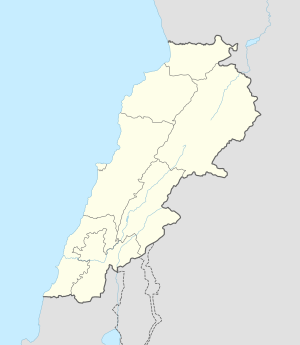Lebaa
Lebaa
لبعا | |
|---|---|
| Coordinates: 33°32′52″N 35°27′11″E / 33.54778°N 35.45306°E / 33.54778; 35.45306 | |
| Country | |
| Governorate | South Governorate |
| District | Jezzine District |
| Area [1] | |
| • Total | 1.07 sq mi (2.77 km2) |
| Elevation [1] | 1,180 ft (360 m) |
| Time zone | UTC+2 (EET) |
| • Summer (DST) | +3 |
Lebaa, (Arabic: لبعا) is a village in the Jezzine District of the South Governorate of Lebanon, about 53 km south of Beirut.[1] Located in the southern part of the country, Lebaa has played a significant role in Lebanon's rich tapestry, contributing to the nation's diverse heritage.
History
In 1838, Eli Smith noted Liba'ah, as a village located in "Aklim et-Tuffah, adjacent to Seida".[2]
In 1875, Victor Guérin travelled in the area, and noted: "I cross a wady; then, climbing to the west of the slopes cultivated by terraces and planted with fig and olive trees, I stop for a few moments in Leba'a, a village divided into two quarters, whose population of 400 souls consists almost exclusively of Maronites. It must occupy the site of an ancient locality.[3]
Geography and Setting
Lebaa is situated in the South Governorate of Lebanon, surrounded by rolling hills and fertile plains. Its strategic location positions it as a gateway between the coastal cities and the mountainous regions, adding to its historical importance as a crossroads of cultures and civilizations. The nearby Litani River enhances the town's natural beauty, providing a vital water source for the community.
Historical significance
With a history dating back centuries, Lebaa has witnessed the ebb and flow of various civilizations. The town's strategic location made it a focal point for trade and cultural exchange, with influences from Phoenician, Roman, and Ottoman eras leaving their mark on the local landscape. Archaeological sites within and around Lebaa tell stories of ancient settlements, contributing to the broader narrative of Lebanon's historical richness.
Cultural Heritage
Lebaa is proud of its cultural heritage, which is evident in its architecture, traditions, and local customs. The town's streets are adorned with historical buildings that showcase a blend of architectural styles, reflecting the passage of time and the influence of different ruling powers. The community actively preserves its traditions through festivals, music, and dance, providing a vibrant expression of Lebanese identity.
Economic Activities
Agriculture has been a cornerstone of Lebaa's economy, with its fertile soil supporting the cultivation of olive groves, vineyards, and a variety of fruits and vegetables. The town's residents also engage in traditional crafts and industries, contributing to the local economy. In recent years, efforts to diversify economic activities have led to the development of small businesses and tourism, further enriching the community.
Community Life
Lebaa thrives on its strong sense of community, with residents actively participating in communal activities and events. The town's social fabric is woven with familial bonds, and traditional hospitality is extended to visitors. The local markets, cafes, and gathering places provide spaces for people to connect, share stories, and celebrate their shared identity.
Challenges and Resilience
Like many communities, Lebaa faces challenges related to infrastructure, economic development, and environmental sustainability. However, the resilience of the community is evident in its collaborative efforts to address these challenges. Local initiatives and governmental support are working towards enhancing the town's infrastructure and fostering sustainable development.
References
- ^ a b c Lebaa, localiban
- ^ Robinson and Smith, 1841, vol 3, 2nd appendix, p. 187
- ^ Guérin, 1880, p. 510: "A onze heures trente-cinq minutes, je continue à m'avancer vers l'est, sur un plateau élevé, pour redescendre ensuite, à onze heures quarante-cinq minutes, dans la direction du sud-sud-est. A midi, je franchis un oued; puis, gravissant verà l'ouest des pentes cultivées par terrasses et plantées de figuiers et d'oliviers, je fais halte quelques instants à Leba'a, village divisé en deux quartiers, dont la population de 400 âmes se compose presque exclusivement de Maronites. Il doit occuper le site d'une localité antique"
Bibliography
- Guérin, V. (1880). Description Géographique Historique et Archéologique de la Palestine (in French). Vol. 3: Galilee, pt. 2. Paris: L'Imprimerie Nationale.
- Robinson, E.; Smith, E. (1841). Biblical Researches in Palestine, Mount Sinai and Arabia Petraea: A Journal of Travels in the year 1838. Vol. 3. Boston: Crocker & Brewster.
External links
- Lebaa, localiban

